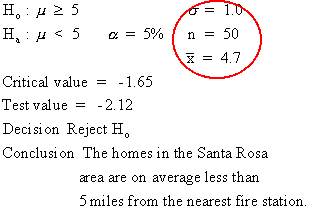Seeing is believing!
Before you order, simply sign up for a free user account and in seconds you'll be experiencing the best in CFA exam preparation.
Basic Question 2 of 8
The Santa Rosa Homeowners are trying to prove that the homes in their area are less than 5 miles from the nearest fire station. The data and hypothesis test is shown below. A Type I error could have been made; a discussion of this error involves ______.
B. going along with the conclusion that homes in the Santa Rosa area are, on average, less than 5 miles from the nearest fire station when in fact the homes are, on average, 5 or more miles from the nearest fire station.
C. concluding that the homes in the Santa Rosa area are, on average, 5 or more miles from the nearest fire station when in fact the homes are, on average, less than 5 miles from the nearest fire station.
D. concluding that the homes in Santa Rosa area are, on average, less than 5 miles from the nearest fire station when in fact the homes are, on average, 5 or more miles from the nearest fire station.

A. going along with the conclusion that homes in the Santa Rosa area are, on average, 5 or more miles from the nearest fire station when in fact the homes are, on average, less than 5 miles from the nearest fire station.
B. going along with the conclusion that homes in the Santa Rosa area are, on average, less than 5 miles from the nearest fire station when in fact the homes are, on average, 5 or more miles from the nearest fire station.
C. concluding that the homes in the Santa Rosa area are, on average, 5 or more miles from the nearest fire station when in fact the homes are, on average, less than 5 miles from the nearest fire station.
D. concluding that the homes in Santa Rosa area are, on average, less than 5 miles from the nearest fire station when in fact the homes are, on average, 5 or more miles from the nearest fire station.
User Contributed Comments 5
| User | Comment |
|---|---|
| vincenthuang | what's the difference between going along and concluding? The descriptions of B and D seem like same. |
| tony1973 | Going along means you cannot conclude but cannot reject it either. |
| whiteknight | can someone explain this one ? |
| bobert | Short answer: Type I: Conclusions are made Type II: No Conclusions made Why?: Type I assumes the null is rejected, and therefore there may be evidence to make a conclusion about the population. H0 + HA = 100% or 1, of all values under the curve. Therefore: HA = 1-H0 because H0 was rejected (not possible values). It is because of this, there seems that there are values which make the alternate potentially true. It is impossible to have values of one condition satisfy the conditions of the other, which is where the conclusion comes from. Type II assumes the null fails to be rejected when it should have in fact been rejected. The reason that no conclusions can be made is this; Again, HA + H0 = 1 of all values under the curve. If H0 fails to be rejected, that says to us that there are possibly values that the conditions of H0 do not follow. For example: H0: x-bar < 15 now say we get a result that happens to be 13. By getting 13 as a result, we have to fail to reject H0 because 13 is indeed less than 15. x-bar cannot therefore be both <15 and =>15. That is why for a hypothesis test you WANT to reject the null to have HA be true. We want to make a conclusion about HA, which would therefore be HA: x-bar => 15. 13 is not though. If your still with me, there cannot be conclusions drawn therefore because you have a value that the hypothesis test CANT be, or you have a Type II Error that makes you think that. |
| mvross | Bobert, very nice explanation. Thank you. |

I passed! I did not get a chance to tell you before the exam - but your site was excellent. I will definitely take it next year for Level II.

Tamara Schultz
Learning Outcome Statements
explain hypothesis testing and its components, including statistical significance, Type I and Type II errors, and the power of a test
CFA® 2024 Level I Curriculum, Volume 1, Module 8.